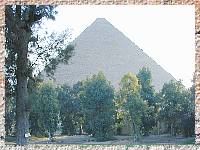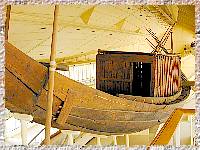 |
The
Great Pyramid of Khufu was called Akhet Khufu - 'The Horizon
of Khufu'. It contains about 2,300,000 blocks of stone, each
of which is thought to weigh on average 2.5 tons. Its base
is 230.33m long, and it rose to a height of 146.59m. The finished
pyramid was surrounded by a Turah limestone wall, over 8m
high, enclosing a court which was paved in limestone. Access
to this court could only be gained via the valley temple,
causeway and mortuary temple.
The causeway was 810m long, and its foundations rose an amazing
40m to carry the corridor from the edge of the plateau down
to the valley temple. Writings left by Heroditus and the discovery
of some carved pieces have led to the belief that the walls
of the causeway were covered by fine relief carvings.
Khufu's mortuary temple was demolished down to bedrock over
the centuries. It is square and much larger than the small
chapels associated with previously built pyramids. What remains
is some black basalt pavement of an open court, sockets for
the granite pillars of the surrounding colonnade and western
recessed bay, and the bedrock cuttings for the outer wall.
The walls were made of fine limestone carved in relief. There
was an inner sanctuary and storage rooms, but it is not known
whether the five statue niches and false door that became
standard later was already part of the plan.
Khufu's pyramid has 3 Queen's pyramids built at the front
of the pyramid
The 1st pyramid is thought to have been built for Queen Hetepheres,
who was the wife of Sneferu and probably the mother of Khufu.
Texts in her burial chamber referred to her as 'Daughter of
the God' and 'Mother of the King'. The burial chamber was
discovered by accident in 1925, in a deep shaft to the north
of the pyramid. This shaft was 27m deep and was blocked with
stones and other debris - at its bottom was a chamber with
an exquisite alabaster sarcophagus and a small sealed alabaster
box containing the queen's internal organs. The chamber also
contained the disassembled parts of two sitting chairs, a
carrying chair, a tube for walking sticks, a headrest and
two sets of silver bracelets - all the essential items for
the private boudoir of a queen.
|
|
The
2nd pyramid might belong to Queen Meritetes - who lived through
the reigns of Sneferu, Khufu and and Khafre.
The
3rd pyramid, which is thought to have belonged to Queen Henutsen,
is the only one of the three Queen's pyramids which still
has its mortuary chapel still intact. This is probably due
to the fact that the chapel was converted during the Twenty-Sixth
Dynasty into a temple of the goddess Isis - the 'Mistress
of the Pyramids', with whom Queen Henutsen came to be identified
during this period.
 |
The
boat pits on the eastern side of the pyramid could have been
symbolic transport mechanisms for the king's ascent to the
heavens - westwards with the setting sun and eastwards with
the rising sun.
These two rectangular boat pits on the southern side were
discovered in 1954 - covered by huge limestone slabs, these
pits contained the dismantled remains of two boats. These
are thought to be the boats which transported Khufu's body
to his pyramid, since it was common practice to bury all the
items connected with the royal funeral close to the final
resting place of the King. So far one of the boats has been
reconstructed - it was found in 1,224 pieces, all of which
had been stitched together with rope. The reassembled vessel
is 43.3m long and 5.9m wide, and is now housed in its own
boat-shaped museum next to the pyramid.
Discovered in 1991, the satellite pyramid does not appear
to have been used as a tomb. Several theories have been put
forward about its function - it could have been a residence
for the king's ka (spirit), it could have housed his viscera,
or else it could have had a role in the king's sed (jubilee)
festival in the afterlife.
Also built around the pyramid were the "Mastabas"
(tombs) of the minor sons of the pharoah and the "Mastabas"
of officials and workers related to the funerary complex.
|